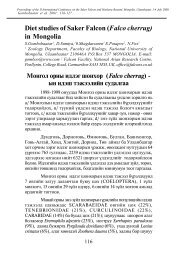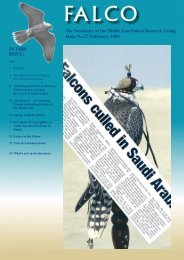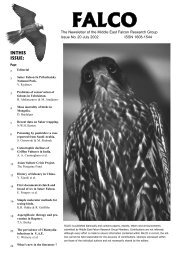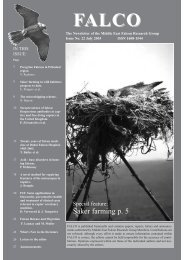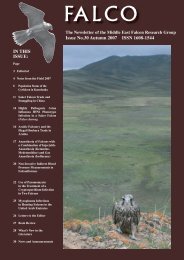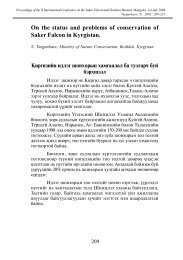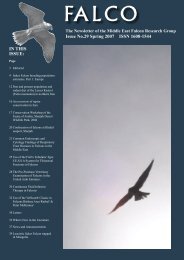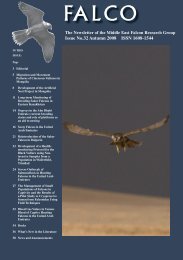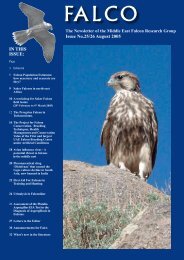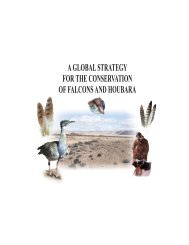Falco 28 - International Wildlife Consultants Ltd.
Falco 28 - International Wildlife Consultants Ltd.
Falco 28 - International Wildlife Consultants Ltd.
Create successful ePaper yourself
Turn your PDF publications into a flip-book with our unique Google optimized e-Paper software.
Brandt’s Vole are poorly understood and population<br />
peaks do not always have a regular cyclic pattern.<br />
Low density populations can persist from 3 to 16 years<br />
between peaks thus it may be a long time before we<br />
can see if an increase in the Brandt’s Vole population<br />
leads to a significant increase in breeding Sakers in our<br />
artificial nest areas. To obtain a greater understanding<br />
of the influence of vole numbers on Saker <strong>Falco</strong>n<br />
breeding densities it may be necessary to establish<br />
several artificial nest areas across the plains. In order<br />
for this approach to be successful we need to identify<br />
areas of steppe with varying densities of Brandt’s<br />
Voles.<br />
In 2006 we undertook a survey of electricity power lines<br />
in our study area to obtain a greater understanding of the<br />
use of power poles and pylons as nesting and perching<br />
sites for raptors. We surveyed electricity transmission<br />
and distribution lines recording the position of nests<br />
and perch sites on the poles and pylons. In a 49 km<br />
stretch of transmission line there were 8 Raven nests<br />
and 4 Upland Buzzard nests, 6 of which were occupied<br />
by Sakers. In a 48 km stretch of distribution line there<br />
were 8 Raven nests, 1 of which was occupied by a<br />
Saker.<br />
wooden ‘A’ type tensioning poles were preferred to<br />
single wooden poles. The number of both metal pylons<br />
and ‘A’ type wooden poles was much lower than the<br />
concrete and single wooden poles along the power<br />
lines, with the former only present at direction changes<br />
in the transmission line and the latter at ca. 3 km<br />
intervals along the distribution lines. Consequently,<br />
there is scope for increasing the availability of potential<br />
Saker <strong>Falco</strong>n nesting sites by providing artificial nests<br />
on concrete and single wooden poles.<br />
A problem with raptor nests on electricity pylons and<br />
poles in Mongolia is that the debris (including wire)<br />
that is often used in nest construction can come into<br />
contact with the electricity cables causing a disruption<br />
in power supply. Consequently, power line companies<br />
employ line workers to remove raptor nests from<br />
the transmission lines, resulting in the destruction of<br />
many nests. We are now developing proposals for the<br />
electricity company to fit ‘nest excluders’ and artificial<br />
nest sites on poles and pylons to reduce the need for<br />
clearance and destruction of raptor nests. Furthermore,<br />
power lines can have a detrimental impact on raptors<br />
and other large birds through electrocution and<br />
collision with the aerial cables. A survey of the power<br />
lines in our study area revealed that raptor mortality<br />
was generally low from April to August. Problems<br />
caused by electrocution of perching birds were mainly<br />
confined to individual poles with a poor configuration<br />
of insulators. These ‘killer poles’ can be identified and<br />
we intend to inform the power companies of ways in<br />
which they can improve the safety of these poles to<br />
reduce raptor mortality.<br />
Figure 2. Nest of Raven built in a dangerous position<br />
on an electricity distribution line. Note trailing wires<br />
from nest structure.<br />
Particular designs of poles and pylons were preferred as<br />
nesting sites; along the transmission line metal pylons<br />
were used as nest sites significantly more frequently<br />
than concrete poles and along the distribution line<br />
Figure 3. Three Upland Buzzards electrocuted at poorly<br />
designed junction point along a distribution line.<br />
Our study area includes two mountain blocks where<br />
raptors occupy natural nest sites on cliffs, slopes and<br />
trees. We surveyed these areas for breeding raptors<br />
11



